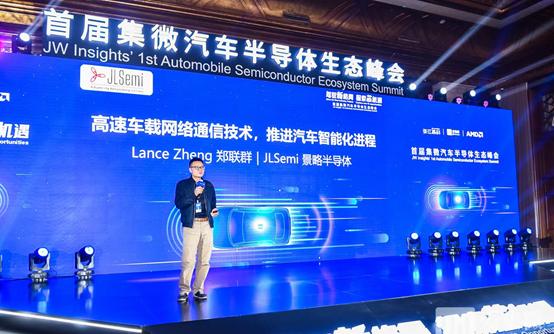
Jiwei Network News, on December 24, the first Jiwei Automotive Semiconductor Ecological Summit was held in Shanghai. Zheng Lianqun, CMO of Jingluo Semiconductor (Shanghai) Co., Ltd., delivered a speech with the theme of "High-speed Vehicle Network Communication Technology, Helping the Process of Automobile Intelligence".
Zheng Lianqun opened with Tesla's tire wear detection function updated last week as an example, pointing out that there are huge technological changes behind the small functional upgrade. The penetration from the cloud to the perceptual level involves the transformation of software and hardware. Tesla's OTA frequency is very high, and it is also its core competitiveness, it has changed the business model, improved the user experience, and also increased its own revenue. Tesla's revenue through the OTA model this year exceeded $1 billion, reflecting the advent of the software-defined car era.
Zheng Lianqun detailed two major technological changes under the software-defined car: one is software thinking, and the new software thinking is the service-oriented SOA architecture, which allows Tier 1 to combine with software providers to develop software and systems faster. A C/S architecture is required here, and each ECU has a Socket-based design that decouples software and hardware. With the introduction of new software thinking, chip developers will need to design Ethernet-appropriate chips with real-time capabilities for cars.
The second is the transformation of the automotive E/E architecture, and the future architecture will become more and more centralized, dividing the architecture according to the physical area. We'll see a lot of SoCs responsible for the control and functionality of different areas, connecting via Ethernet, and expect 100 connections in high-end models.
With the beginning of the road of change, we will also face difficulties and challenges before landing. Zheng Lianqun said that in the future, automotive technology will face three major challenges: data explosion, long-distance communication, and data transmission reliability and security.
Zheng Lianqun introduced that at present, Jingluo Semiconductor focuses on the three major sectors of automotive, industrial and Netcom, and correspondingly lays out the Cheetah series of high-speed automotive data and visual transmission product lines, including 10G/2.5G/GE/FE Auto T1 PHY and 12G/6G Auto SerDes; SailFish series of network switching product lines, including SOHO, enterprise SMB and vehicle TSN switching chips Antelope's high-speed industrial Ethernet product line includes 10G/5G/2.5G/GE/FE PHY chips.
Thanks to the development of in-vehicle networks, the isolation of automotive in-vehicle systems has changed, thus bringing more possibilities, and the automotive vision market is one of them. In August this year, Jingluo Semiconductor and Weier Signed a strategic cooperation agreement to establish a new semiconductor chip joint venture, aiming to cooperate in the field of in-vehicle vision technology, and work together to provide end-to-end high-speed image data transmission, processing and network communication solutions for the next generation of intelligent vehicles.
Zheng Lianqun said that Jingluo Semiconductor is laying out the computing team, hoping to integrate data transmission and exchange, apply it to different fields, and accelerate the process of intelligence.
(Proofreading/Sharon)